Last Updated on December 14, 2022 by Sultana Parvin
We use different cooking terminologies or culinary terms in our kitchen. If we know these terms it will help us to understand a recipe easier. In our cooking time, we use different culinary terminology, different cutting terms, different shapes, and different terms for mixing. There are different culinary terms for different cuisines. Like Fench cuisine uses french culinary terms.
Table of Contents
Culinary Terms Definition
A culinary term is a word or phrase used in cooking, food preparation, or food service. It may refer to a cooking technique, a style of food, or a utensil. Culinary terms can be found in cookbooks, manuals, and other food-related texts.
Why Do We Need to Know The Different Terminologies in Cooking?
Different terminologies are used in cooking to describe different methods of food preparation. These terms can be used to describe the same thing in different ways or to describe different things altogether. Knowing the different terminologies can help you to understand the instructions given in a recipe, and can also help you to communicate with other cooks.
What Are Some Cooking Terminologies or Terms?
There are many different terminologies used in cookery, which can be confusing for someone who is not familiar with them. Here is a quick guide to some of the most common terms:
Cooking Terminologies in Cooking Terms:
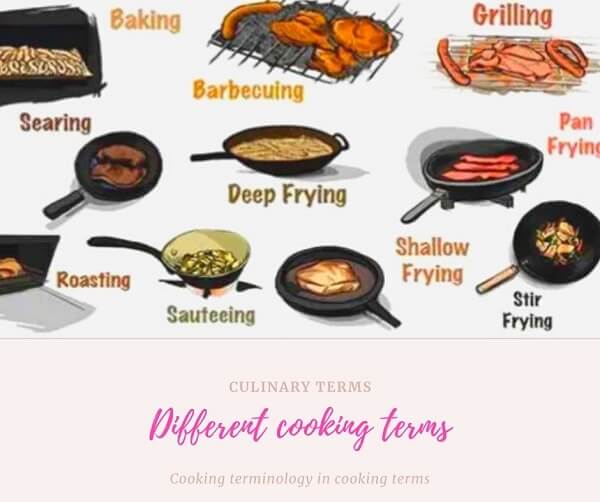
Al dente: Pasta or rice that is cooked until it is firm but not hard.
Baking: To cook food with dry heat, normally in the oven. Baking can be done with coal or hot stones. Some examples of baking products are cake, cookies, bread, etc.
Barbecue: To grill meat or fish outdoors use a wood fire or an open burner using charcoal. This type of cooking is usually slow and long, but it gives direct heat to the food. BBQ food is favored by everyone because of its smokey smell.
Baste: To keep the food with gravy while cooking or to prevent it from drying in the pan. To make the meat moist, pour fat or juice over the meat during the cooking.
Blanch: To cook slightly by putting into the full boiled water. This style of cooking is followed in South Asian countries, like Japan, Korea, and China.
Boil: To heat any liquid item or water until bubbles break on the surface. In the case of oil, it is seen when a drop of water or salt is put in it.
Broil: To cook or grill under strong and direct heat.
Fry: To cook in hot oil. Cooking in a pan with a low layer of oil is called Pan-frying or Sautéing. Cooking in one to two-inch layers of hot oil is called Shallow-frying. Cooking in deep hot oil is called Deep-frying.
Glaze: To apply a thin glossy layer of sugar syrup for making the food crispy and sweetened.
Gratin: To bake a cooked dish with a golden/brown crust of cheese, bread crumbs, or sauce on top of the food.
Grill: To cook with intense heat on an open burner or maybe grilled inside the oven.
Pan-Broil: To cook in a hot uncovered fry pan, while the oil or fat can be poured off as it accumulates.
Parboil: To partially cook an item through boiling, or to blanch. Usually, this procedure is followed by seasoning an item before final cooking.
Pinch: A pinch is a very little amount of tiny particles like salt, spice, etc that can be held between the thumb and forefinger.
Planked: It means the food is cooked on a thick hardwood plank.
Poach: To cook very gently, like egg poach, while its hot liquid is kept inside covering the slightly hard portion.
Render: To melt solid fat into liquid by heating slowly.
Roast: To cook meat, potato, or other solid food by dry heat in an oven.
Sauté: To fry food in a low layer of oil.
Scald: To reduce temperature just below the boiling point, so that bubbles do not break.
Sear: To turn food color quickly into brown by intense heat. This method increases shrinkage but develops flavor and improves appearance.
Sift: To add one or more grated or ground dry ingredients through a sieve.
Simmer: To cook over low heat, usually liquid at a temperature of about 180°. Bubbles at the surface of the liquid should break slowly.
Steam: To cook over steam or inside a pressure cooker. The heat from steam can be taken by putting a rack inside a deep dish with boiling water and a sealed cover or allowing the stem to pass through a hole in the top cover.
Stew: To simmer a small amount of liquid slowly and for a long time.
Culinary Terms: Terms for Different Shapes or Forms of food
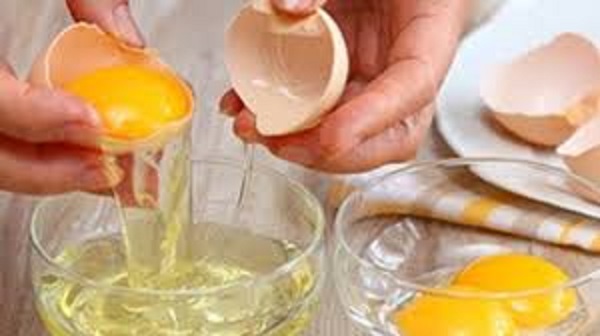
Beat: To mix an egg or other food mixture rapidly for making a foamy or smooth and light mixture by blocking air into the mixture.
Clarify: To separate a liquid from its solid content, and give it a clear liquid form.
Cream: The soft and foamy form of butter or egg and sugar. The cream is prepared by beating with egg bitter or manually by beating continually with a spoon to make the food ingredients smooth and soft. It is applied to other food, like cake, custard, or such deserts.
Degrease: To extract fat from the top surface of soup, stews, or stock. Normally the boiled liquid fatty food is cooled in a refrigerator to allow forming fat at the top. So that the layer of fat can be removed easily.
Knead: Press the dough with your hand palms and fingers as much as possible or use any other mechanical pressing and rotating machine until the gluten in the flour is developed. Example: paratha dough.
Lukewarm: Neither warm nor hot; almost the same as the body temperature.
Puree: Mashed foods either through boiling or using a hand, by rubbing through a sieve or food mill, or by whirling in a blender, or food processor.
Plump: To soak dried fruits in water or another liquid food item until they are softened.
Skim: To remove fat or other impurities from the surface while cooking with a view to producing a clear and clean liquid form of the food.
Steep: To boil a food item in fully boiled water with a view to change the color, flavor, or other qualities.
Sterilize: To destroy micro-organisms of any item by flushing in boiled water, or dry heating, or putting in the steam.
Truss: To secure chicken or poultry with string or skewers, so that the shape is not broken while cooking.
Whip: To create foam or expansion of an item such as cream or egg whites through rapidly beating or using a beater machine.
Cooking Terminologies: Mixing and Cooking Terms
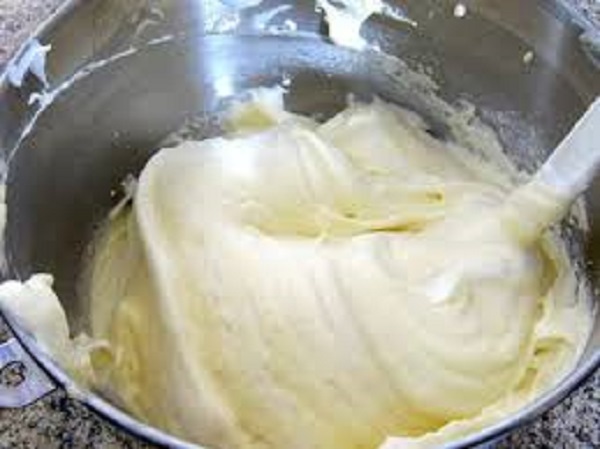
Batter: It is a liquid mixture of flour with water or milk, or another ingredient. It should be thin enough to pour.
Blend: To crash into powder or liquid mixture of one or more ingredients through heavy grinding or by use of a blender machine.
Caramelize: To form sugar into liquid brown form through boiling for getting a special taste.
Dissolve: Mix any dry food item into a solution of a liquid, so that the dry item is no more visible.
Dredge: To sprinkle the coating of flour or crushed bread on the outer surface of other prepared food before cooking.
Drizzle: To sprinkle a few drops of liquid lightly over some prepared food irregularly.
Garnish: To decorate a food dish to increase its attraction. Slices of vegetables, lemon, fried onion, fruit, etc can be used for garnishing.
Marinate: To soak, brush or season meat, poultry, and seafood in the liquid mixture of other food ingredients with a view to softening their fleshes and allowing other ingredients to be absorbed by the main food item.
Meunier: Scour with flour and sautéd in egg crumb or butter.
Mix: To combine ingredients usually by stirring.
Pickle: Preserve vegetables and fruits in saltwater.
Stir: To mix ingredients properly with a circular motion or to maintain even heating while cooking.
Terms for Different Cutting of Food in Culinary Terminologies
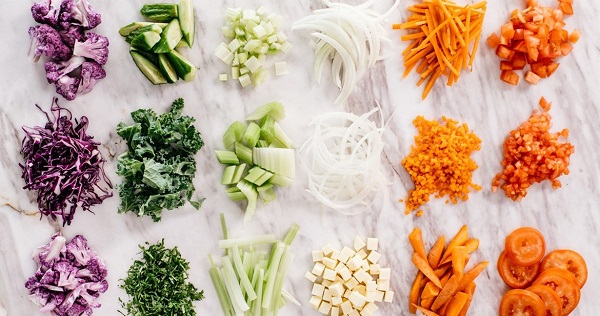
Chop: To cut solid food items into small pieces with a sharp knife or another chopping machine. Usually, onion, tomato, green chili, coriander leaves, etc. are chopped and used for cooking.
Dice: To cut solid food items into a small cube shape. Usually, a Dicer machine is used to keep the uniform size.
Fillet: To make pieces of fish or meat flesh, usually flat type pieces removed from bones of meat or fish.
Flake: To break a food item into small pieces.
Grate: To create various irregular-shaped small pieces of a food item using a hand grater.
Grind: To create tiny particles of a solid food item using a hand grinder or mechanical grinding machine.
Julienne: To cut onion, cheese, vegetables, fruits, etc. into thin slices.
Mince: To cut or chop food into extremely small pieces.
Pare: To remove the outermost skin of a fruit or vegetable.
Peel: To remove the complete skin or peels from vegetables or fruits.
Pit: To remove pits (deep part) from fruits; for example apples, and pineapple have pits.
Score: To cut narrow grooves or slashes through the outer surface of the food.
Shred: To cut or tear into small, long, narrow pieces.
Vegetable Cookery Terminologies or Culinary Terms of Vegetables
Culinary terms related to vegetables can be divided into several categories.
First, there are terms that describe how a vegetable is prepared, such as blanched, braised, or roasted.
Second, there are terms that describe the physical appearance of a vegetable, such as julienned, minced, or diced.
Finally, there are terms that describe the flavor of a vegetable, such as sweet, sour, or savory.
How a Vegetable is Prepared?
Blanching is a cooking method in which a vegetable is briefly cooked in boiling water and then immediately plunged into cold water. This process sets the color of the vegetable and makes it more tender.
Braising is a cooking method in which a vegetable is cooked slowly in a small amount of liquid. This method creates a rich, flavorful dish.
Roasting is a cooking method in which a vegetable is cooked in a hot oven. This method browns and caramelizes the vegetable, resulting in a sweeter flavor.
Caramelizing – This is a cooking technique in which vegetables are cooked over low heat until they turn a golden brown color. This helps to bring out the natural sweetness of the vegetables.
Glazing – This is a cooking technique in which vegetables are coated with a thin layer of liquid (often sugar or oil) and then cooked until the liquid evaporates. This helps to create a shiny, smooth surface on the vegetables.
Macerating – This is a cooking technique in which vegetables are soaked in a flavored liquid (often wine or vinegar) for a period of time. This helps to tenderize the vegetables and infuse them with flavor.
Pickling – This is a cooking technique in which vegetables are soaked in a vinegar or brine solution. This helps to preserve the vegetables and give them a tangy flavor.
Sautéing – This is a cooking technique in which vegetables are cooked quickly in a small amount of hot fat. This helps to preserve their flavor and texture.
Steaming – This is a cooking technique in which vegetables are cooked in a small amount of water or other liquid. This helps to preserve their nutrients and color.
Physical Appearance of a Vegetable
Julienning cuts vegetables into long, thin strips.
Mincing is a cut that results in very small pieces, about the size of rice grains.
Dicing is a cut that results in small, square pieces.
The flavor of a Vegetable
Sweet flavors are typically associated with fruits, but some vegetables can also be quite sweet.
Sour flavors are usually created by adding acidic ingredients, such as lemon juice or vinegar.
Savory flavors are typically rich and salty.
Beef Cooking Terms
Beef cooking terms can seem like a foreign language, but once you learn them, they’ll become second nature. Here are some common beef cooking terms to get you started:
Beef roast: A large, usually boneless piece of beef that is typically roasted in the oven. Beefsteak: A thick, boneless steak cut from the beef roast.
Ground beef: Beef that has been ground or minced into small pieces.
Stewing beef: Beef that is cut into small cubes and typically used for stew or soup.
Braising: A cooking method where beef is first browned, then cooked in a small amount of liquid in a covered pot.
Barbecuing: A cooking method where beef is cooked over an open flame.
Grilling: A cooking method where beef is cooked over a hot, dry surface.
What are the Different Baking Terminologies?
Baking terminology can be confusing, so here’s a list of common baking terms to help you out.
Batter – A mixture of flour, liquid, eggs, and other ingredients used to make cakes, pancakes, and other baked goods.
Blind bake – Baking a crust or pastry without filling, usually done to prevent the crust from becoming soggy.
Blancmange – A sweet or savory pudding made with milk, cornstarch, and gelatin.
Bloom – The process of gelatinization, where gelatin absorbs water and swells to form a gel.
Boil – To heat a liquid until it reaches its boiling point, where it turns into steam.
Boule – A round loaf of bread.
Brioche – A rich, eggy bread made with butter and milk.
Brown – To cook food until it turns a brown color, usually done by roasting, grilling, or baking.
Bulk fermentation – The first step in making bread, where the dough is left to rise in a warm place until it doubles in size.
Cake – A sweet, often layered, a dessert made with flour, sugar, eggs, and butter.
Creaming – Beating butter and sugar together until they are light and fluffy.
Custard – A creamy mixture made with milk, eggs, and sugar, often used as a filling for pies and pastries.
Denaturation – The process of breaking down proteins, usually done by heating.
Dough – A mixture of flour, water, and other ingredients used to make bread, pastries, and other baked goods.
Drape – To cover a dough or pastry with a cloth, usually done to prevent the dough from drying out.
Egg wash – A mixture of eggs and water is used to brush on dough or pastry, usually done to give the baked goods a shiny or golden color.
Emulsification – The process of combining two immiscible liquids, such as oil and water, to create a smooth mixture.
Fermentation – The process of yeast converting sugar into alcohol and carbon dioxide, which gives bread its flavor and texture.
Flour – A powder made from grinding grains, used to make doughs and batters.
Food processor – A kitchen appliance used to chop, grind, or puree food.
Gelatinization – The process of gelatin absorbing water and swelling to form a gel.
Glaze – A thin, often sweet, the coating used to give food a shiny or glossy appearance.
Gluten – A protein found in wheat and other grains, responsible for the elastic texture of dough.
Hydration – The process of adding water to flour to make dough.
Icing – A sweet, often thick, the coating used to decorate or flavor cakes and other desserts.
Knead – To work the dough with your hands until it is smooth and elastic.
Leavening – An ingredient, such as yeast, baking soda, or baking powder, used to make dough rise.
Levain – A starter used to make bread, made with flour, water, and yeast.
Macaron – A French cookie made with almond flour, egg whites, and sugar.
Meringue – A sweet mixture made with egg whites and sugar, often used to top pies and desserts.
Oven spring – The final rise of bread dough in the oven.
Proof – The process of letting dough or yeast rise in a warm place.
Roux – A mixture of flour and fat used to thicken sauces and soups.
Score – To make shallow cuts on the surface of the dough, usually done to control the direction of the bread’s rise.
Slurry – A mixture of water and flour used to thicken soups and sauces.
Starter – A mixture of flour, water, and yeast used to make bread and other fermented foods.
Steam – The process of cooking food in steam, is often used to cook delicate foods such as fish and vegetables.
Straight dough – A dough that is mixed and kneaded all at once, without any fermentation.
Temper – To slowly heat a substance, usually eggs, to prevent them from cooking too quickly or curdling.
Tin – A baking pan, usually made of metal, used to bake cakes, cookies, and other desserts.
Yeast – A microorganism used to leaven bread and other doughs.
How Important are Cooking Terminologies and Procedures?
Cooking terms are important because they provide a common language for cooks of all skill levels to communicate with one another. Without a common language, it would be very difficult for cooks to communicate with one another about recipes, cooking techniques, and other important information. Cooking terms also help to standardize recipes so that they can be easily followed and replicated. Without standardized recipes, it would be very difficult for cooks to replicate dishes that they have eaten or cooked in the past.
Cooking terminologies are also important because they can help to ensure that food is cooked properly. Certain cooking terms, such as “sauté” or “bake,” have very specific meanings that must be followed in order to produce a dish that is cooked correctly. If a cook does not follow the proper cooking terms, they may end up with a dish that is overcooked, undercooked, or otherwise not up to par.
In short, cooking terms are important because they provide a common language for cooks, help to standardize recipes, and can ensure that food is cooked properly. Without cooking terms, the culinary world would be a much more difficult place.
I hope these cooking terminologies will help you a lot. If you want to chop easily in a few seconds, you can use Ninja Chopper. I love Ninja chopper for chopping any kinds of vegetables and food.
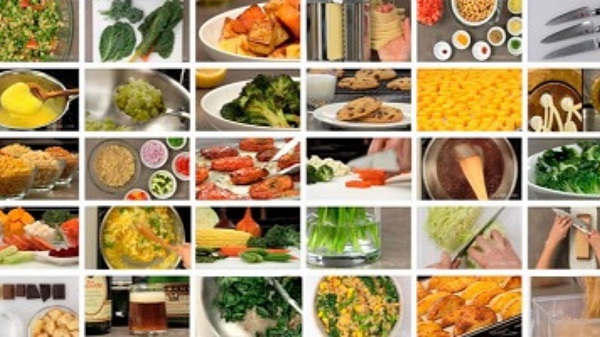
[…] of ingredients and cooking methods used in both cuisines, as well as the common ingredients and cooking methods that are shared between them. By comparing the similarities and differences between the two […]
Comments are closed.